Abstract
Preeclampsia (PE) and eclampsia (E) are potentially life-threatening conditions that can occur during human pregnancy. Generally considered to be different degrees of severity of the same disease process, the PE/E syndrome is thought to be predominantly genetic in origin, although its exact etiology and genetics are not fully understood. Here we report results of a genomewide linkage search for the gene(s) responsible for susceptibility to PE/E, using 15 informative pedigrees and 90 polymorphic DNA markers from all autosomes. Because of uncertainties concerning inheritance and diagnosis, four different models that assume maternal gene expression have been used to carry out LOD-score analysis. The region between D4S450 and D4S610 (2.8 cM) on the long arm of chromosome 4 was identified as a strong candidate region for a PE/E-susceptibility locus. The maximum multipoint LOD score within this interval was 2.9. Analysis of markers in the region around D4S450 and D4S610 by the affected-pedigree-member method also supported the possibility of a susceptibility locus in this region. However, to verify or exclude definitively linkage to this region, other groups of PE/E pedigrees will be required.
Full text
PDF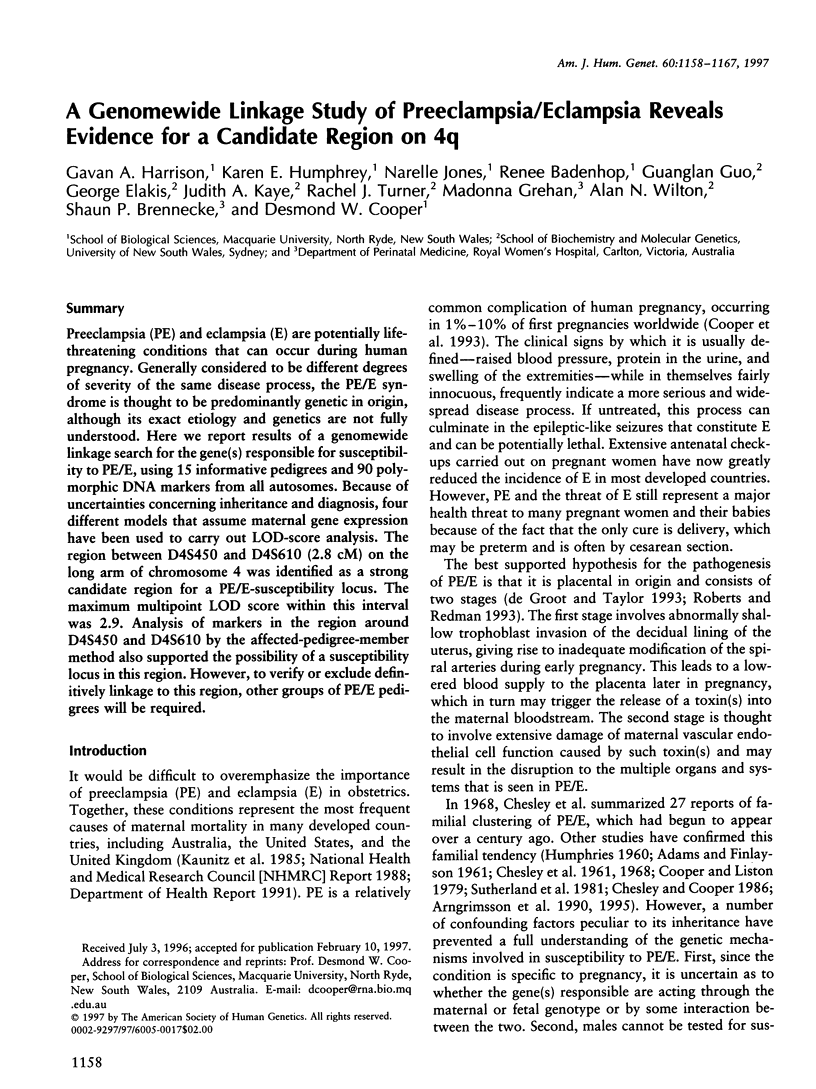
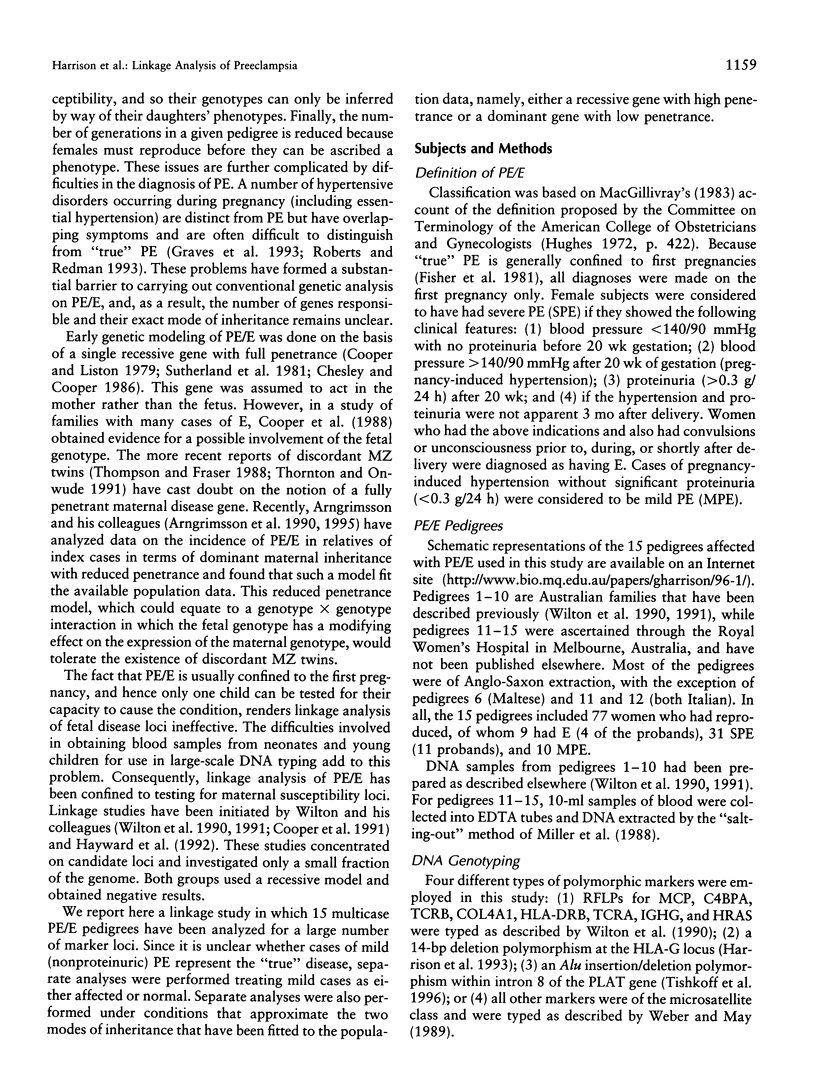
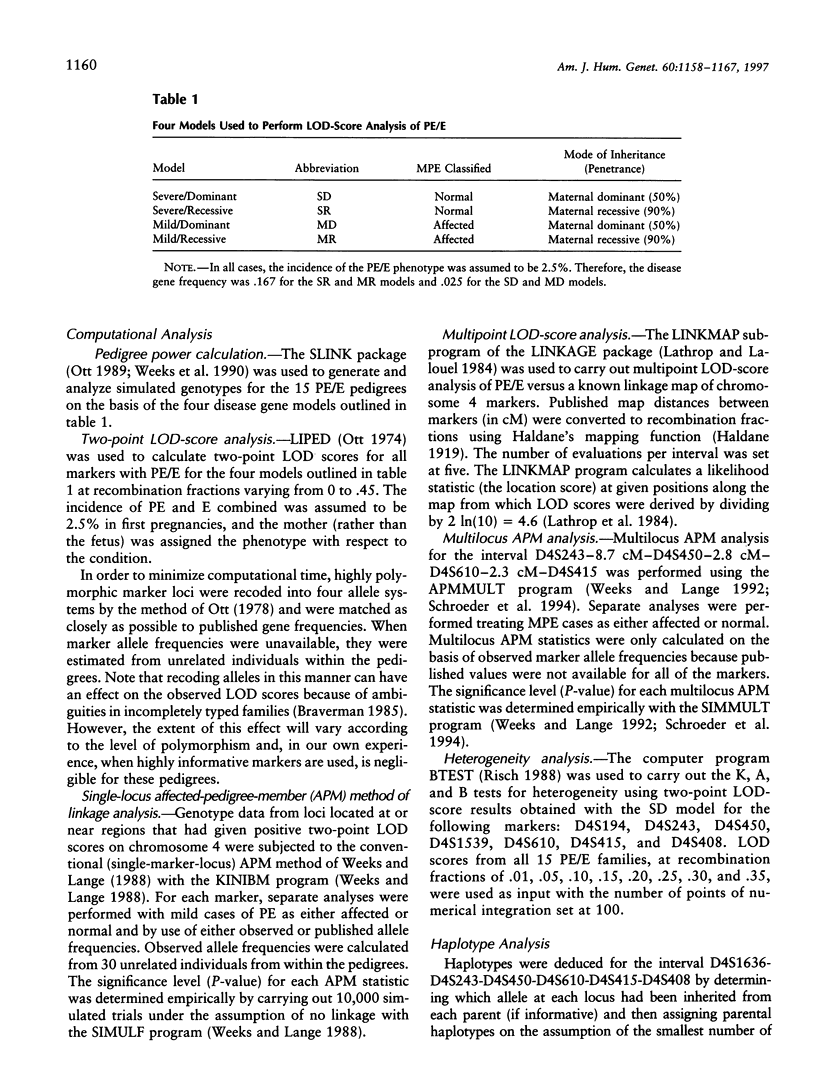
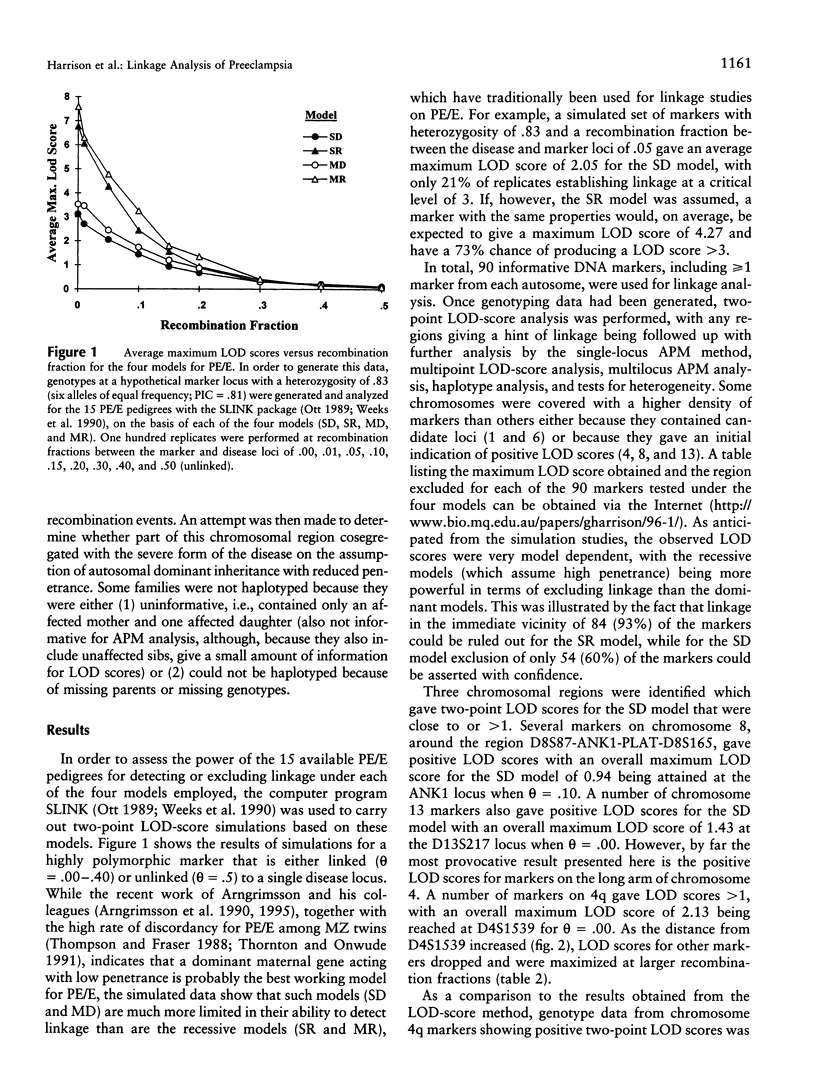
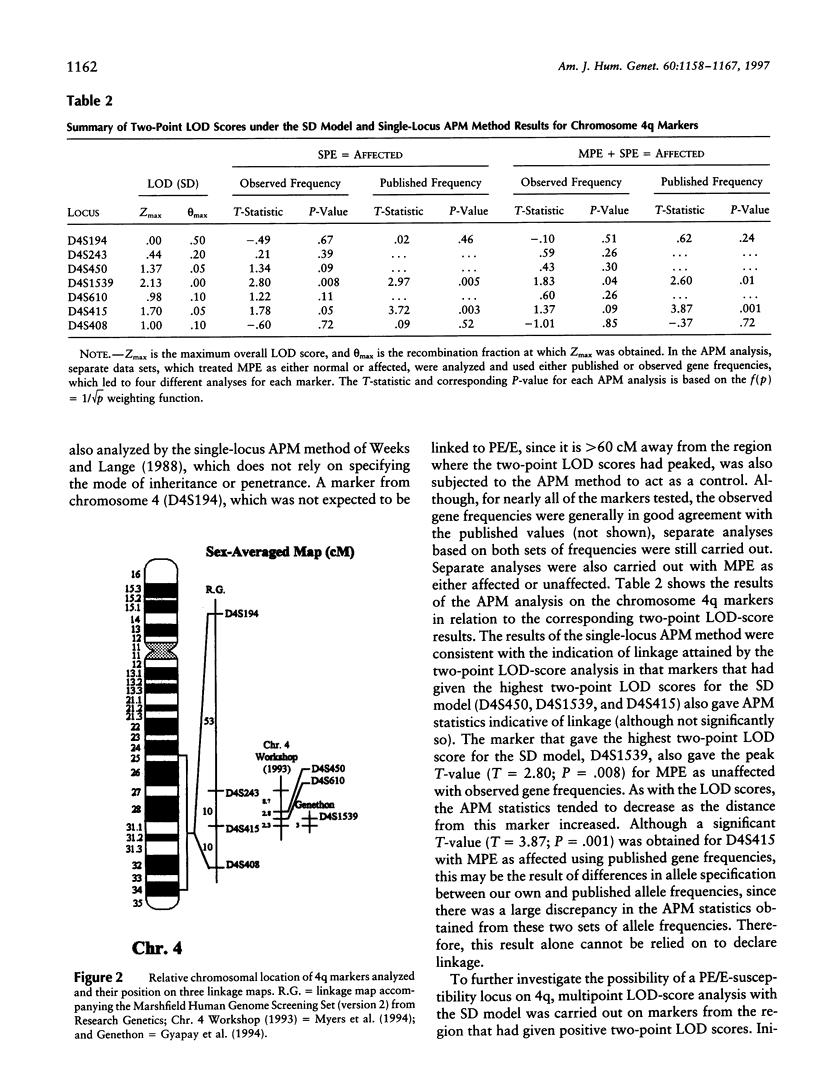
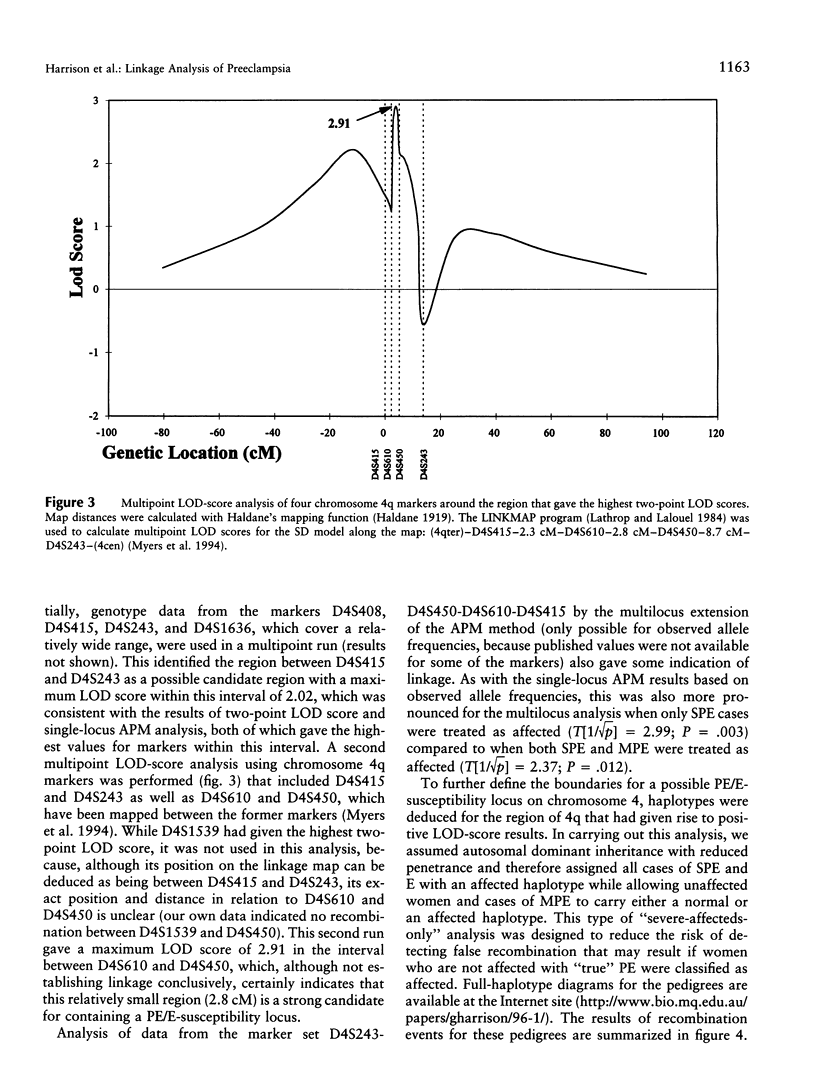

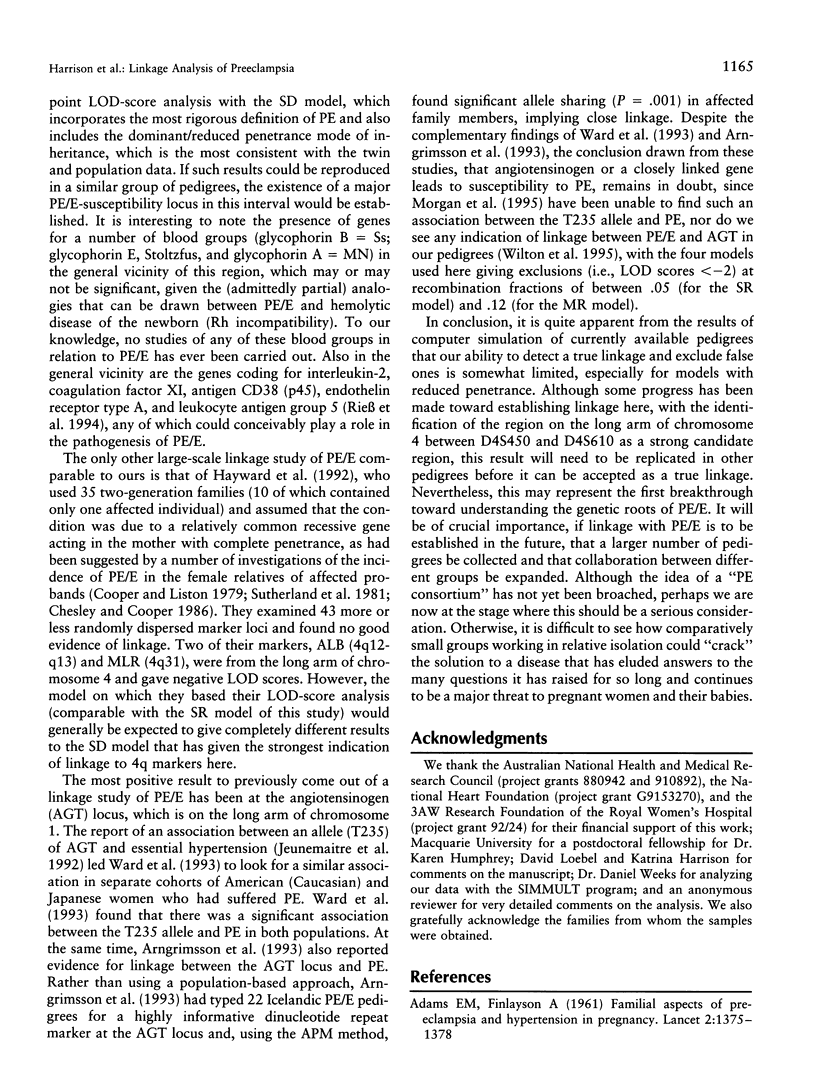

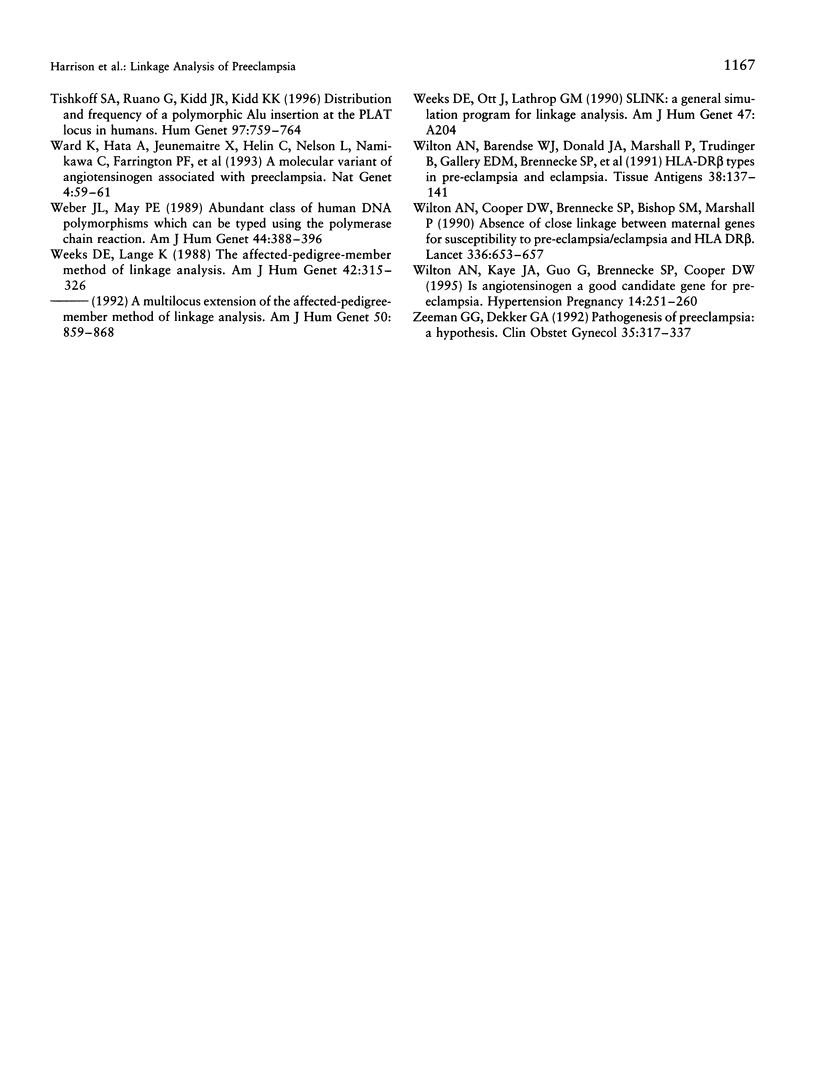
Selected References
These references are in PubMed. This may not be the complete list of references from this article.
- ADAMS E. M., FINLAYSON A. Familial aspects of pre-eclampsia and hypertension in pregnancy. Lancet. 1961 Dec 23;2(7217):1375–1378. doi: 10.1016/s0140-6736(61)91197-7. [DOI] [PubMed] [Google Scholar]
- Arngrimsson R., Björnsson S., Geirsson R. T., Björnsson H., Walker J. J., Snaedal G. Genetic and familial predisposition to eclampsia and pre-eclampsia in a defined population. Br J Obstet Gynaecol. 1990 Sep;97(9):762–769. doi: 10.1111/j.1471-0528.1990.tb02569.x. [DOI] [PubMed] [Google Scholar]
- Arngrímsson R., Purandare S., Connor M., Walker J. J., Björnsson S., Soubrier F., Kotelevtsev Y. V., Geirsson R. T., Björnsson H. Angiotensinogen: a candidate gene involved in preeclampsia? Nat Genet. 1993 Jun;4(2):114–115. doi: 10.1038/ng0693-114. [DOI] [PubMed] [Google Scholar]
- Braverman M. S. An algorithm to improve the computational efficiency of genetic linkage analysis. Comput Biomed Res. 1985 Feb;18(1):24–36. doi: 10.1016/0010-4809(85)90004-7. [DOI] [PubMed] [Google Scholar]
- CHESLEY L. C., COSGROVE R. A., ANNITTO J. E. Pregnancy in the sisters and daughters of eclamptic women. Pathol Microbiol (Basel) 1961;24:662–666. doi: 10.1159/000161178. [DOI] [PubMed] [Google Scholar]
- Chesley L. C., Annitto J. E., Cosgrove R. A. The familial factor in toxemia of pregnancy. Obstet Gynecol. 1968 Sep;32(3):303–311. [PubMed] [Google Scholar]
- Chesley L. C., Cooper D. W. Genetics of hypertension in pregnancy: possible single gene control of pre-eclampsia and eclampsia in the descendants of eclamptic women. Br J Obstet Gynaecol. 1986 Sep;93(9):898–908. doi: 10.1111/j.1471-0528.1986.tb08006.x. [DOI] [PubMed] [Google Scholar]
- Cooper D. W., Hill J. A., Chesley L. C., Bryans C. I. Genetic control of susceptibility to eclampsia and miscarriage. Br J Obstet Gynaecol. 1988 Jul;95(7):644–653. doi: 10.1111/j.1471-0528.1988.tb06524.x. [DOI] [PubMed] [Google Scholar]
- Cooper D. W., Liston W. A. Genetic control of severe pre-eclampsia. J Med Genet. 1979 Dec;16(6):409–416. doi: 10.1136/jmg.16.6.409. [DOI] [PMC free article] [PubMed] [Google Scholar]
- Fisher K. A., Luger A., Spargo B. H., Lindheimer M. D. Hypertension in pregnancy: clinical-pathological correlations and remote prognosis. Medicine (Baltimore) 1981 Jul;60(4):267–276. [PubMed] [Google Scholar]
- Graves S. W., Seely E. W., Williams G. H. Genes, phenotypes and hypertensive pregnancies. Nat Genet. 1993 May;4(1):7–8. doi: 10.1038/ng0593-7. [DOI] [PubMed] [Google Scholar]
- Gyapay G., Morissette J., Vignal A., Dib C., Fizames C., Millasseau P., Marc S., Bernardi G., Lathrop M., Weissenbach J. The 1993-94 Généthon human genetic linkage map. Nat Genet. 1994 Jun;7(2 Spec No):246–339. doi: 10.1038/ng0694supp-246. [DOI] [PubMed] [Google Scholar]
- Harrison G. A., Humphrey K. E., Jakobsen I. B., Cooper D. W. A 14 bp deletion polymorphism in the HLA-G gene. Hum Mol Genet. 1993 Dec;2(12):2200–2200. doi: 10.1093/hmg/2.12.2200-a. [DOI] [PubMed] [Google Scholar]
- Hayward C., Livingstone J., Holloway S., Liston W. A., Brock D. J. An exclusion map for pre-eclampsia: assuming autosomal recessive inheritance. Am J Hum Genet. 1992 Apr;50(4):749–757. [PMC free article] [PubMed] [Google Scholar]
- Jeunemaitre X., Soubrier F., Kotelevtsev Y. V., Lifton R. P., Williams C. S., Charru A., Hunt S. C., Hopkins P. N., Williams R. R., Lalouel J. M. Molecular basis of human hypertension: role of angiotensinogen. Cell. 1992 Oct 2;71(1):169–180. doi: 10.1016/0092-8674(92)90275-h. [DOI] [PubMed] [Google Scholar]
- Kaunitz A. M., Hughes J. M., Grimes D. A., Smith J. C., Rochat R. W., Kafrissen M. E. Causes of maternal mortality in the United States. Obstet Gynecol. 1985 May;65(5):605–612. [PubMed] [Google Scholar]
- Lathrop G. M., Lalouel J. M. Easy calculations of lod scores and genetic risks on small computers. Am J Hum Genet. 1984 Mar;36(2):460–465. [PMC free article] [PubMed] [Google Scholar]
- Lathrop G. M., Lalouel J. M., Julier C., Ott J. Strategies for multilocus linkage analysis in humans. Proc Natl Acad Sci U S A. 1984 Jun;81(11):3443–3446. doi: 10.1073/pnas.81.11.3443. [DOI] [PMC free article] [PubMed] [Google Scholar]
- Miller S. A., Dykes D. D., Polesky H. F. A simple salting out procedure for extracting DNA from human nucleated cells. Nucleic Acids Res. 1988 Feb 11;16(3):1215–1215. doi: 10.1093/nar/16.3.1215. [DOI] [PMC free article] [PubMed] [Google Scholar]
- Morgan L., Baker P., Broughton Pipkin F., Kalsheker N. Pre-eclampsia and the angiotensinogen gene. Br J Obstet Gynaecol. 1995 Jun;102(6):489–490. doi: 10.1111/j.1471-0528.1995.tb11324.x. [DOI] [PubMed] [Google Scholar]
- Myers R. M., Goold R. D., van Ommen G. J. Report and abstracts of the Third International Workshop on Human Chromosome 4 Mapping. Palo Alto, California, July 10-11, 1993. Cytogenet Cell Genet. 1994;66(4):218–236. [PubMed] [Google Scholar]
- Ott J. Estimation of the recombination fraction in human pedigrees: efficient computation of the likelihood for human linkage studies. Am J Hum Genet. 1974 Sep;26(5):588–597. [PMC free article] [PubMed] [Google Scholar]
- Riess O., Winkelmann B., Epplen J. T. Toward the complete genomic map and molecular pathology of human chromosome 4. Hum Genet. 1994 Jul;94(1):1–18. doi: 10.1007/BF02272834. [DOI] [PubMed] [Google Scholar]
- Risch N. A new statistical test for linkage heterogeneity. Am J Hum Genet. 1988 Feb;42(2):353–364. [PMC free article] [PubMed] [Google Scholar]
- Roberts J. M., Redman C. W. Pre-eclampsia: more than pregnancy-induced hypertension. Lancet. 1993 Jun 5;341(8858):1447–1451. doi: 10.1016/0140-6736(93)90889-o. [DOI] [PubMed] [Google Scholar]
- Schroeder M., Brown D. L., Weeks D. E. Improved programs for the affected-pedigree-member method of linkage analysis. Genet Epidemiol. 1994;11(1):69–74. doi: 10.1002/gepi.1370110107. [DOI] [PubMed] [Google Scholar]
- Sutherland A., Cooper D. W., Howie P. W., Liston W. A., MacGillivray I. The indicence of severe pre-eclampsia amongst mothers and mothers-in-law of pre-eclamptics and controls. Br J Obstet Gynaecol. 1981 Aug;88(8):785–791. doi: 10.1111/j.1471-0528.1981.tb01304.x. [DOI] [PubMed] [Google Scholar]
- Thornton J. G., Onwude J. L. Pre-eclampsia: discordance among identical twins. BMJ. 1991 Nov 16;303(6812):1241–1242. doi: 10.1136/bmj.303.6812.1241. [DOI] [PMC free article] [PubMed] [Google Scholar]
- Tishkoff S. A., Ruano G., Kidd J. R., Kidd K. K. Distribution and frequency of a polymorphic Alu insertion at the plasminogen activator locus in humans. Hum Genet. 1996 Jun;97(6):759–764. doi: 10.1007/BF02346186. [DOI] [PubMed] [Google Scholar]
- Ward K., Hata A., Jeunemaitre X., Helin C., Nelson L., Namikawa C., Farrington P. F., Ogasawara M., Suzumori K., Tomoda S. A molecular variant of angiotensinogen associated with preeclampsia. Nat Genet. 1993 May;4(1):59–61. doi: 10.1038/ng0593-59. [DOI] [PubMed] [Google Scholar]
- Weber J. L., May P. E. Abundant class of human DNA polymorphisms which can be typed using the polymerase chain reaction. Am J Hum Genet. 1989 Mar;44(3):388–396. [PMC free article] [PubMed] [Google Scholar]
- Weeks D. E., Lange K. The affected-pedigree-member method of linkage analysis. Am J Hum Genet. 1988 Feb;42(2):315–326. [PMC free article] [PubMed] [Google Scholar]
- Wilton A. N., Barendse W. J., Donald J. A., Marshall P., Trudinger B., Gallery E. D., Brennecke S. P., Cooper D. W. HLA-DRB types in pre-eclampsia and eclampsia. Tissue Antigens. 1991 Sep;38(3):137–141. doi: 10.1111/j.1399-0039.1991.tb02027.x. [DOI] [PubMed] [Google Scholar]
- Wilton A. N., Cooper D. W., Brennecke S. P., Bishop S. M., Marshall P. Absence of close linkage between maternal genes for susceptibility to pre-eclampsia/eclampsia and HLA DR beta. Lancet. 1990 Sep 15;336(8716):653–657. doi: 10.1016/0140-6736(90)92149-c. [DOI] [PubMed] [Google Scholar]
- Zeeman G. G., Dekker G. A. Pathogenesis of preeclampsia: a hypothesis. Clin Obstet Gynecol. 1992 Jun;35(2):317–337. [PubMed] [Google Scholar]
- de Groot C. J., Taylor R. N. New insights into the etiology of pre-eclampsia. Ann Med. 1993 Jun;25(3):243–249. doi: 10.3109/07853899309147870. [DOI] [PubMed] [Google Scholar]


